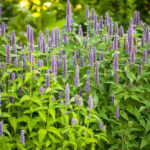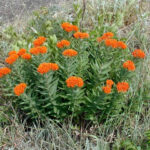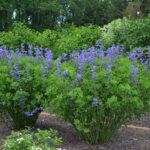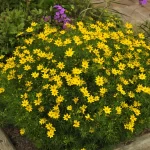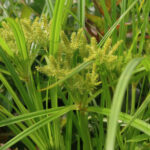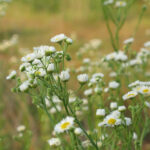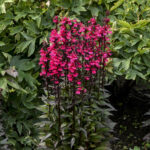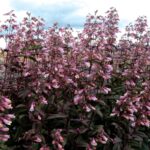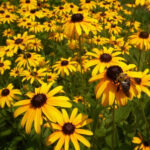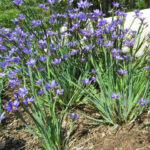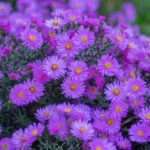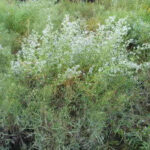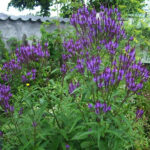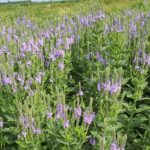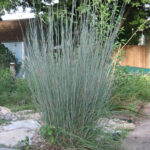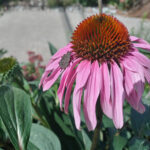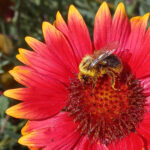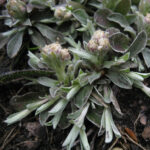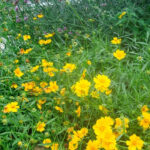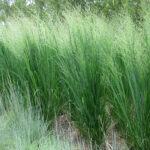Native Plants Used in the Hellstrip Garden
My Mostly Native Plant Hellstrip Garden with Names
Just taking a little stroll around half of my tree lawn to see what the insects are doing right now. It just rained. My plants are happy.
Look at that. Butterfly milkweed grown from seed this past winter, and it has flowers. Despite what the naysayers say in the first year. We got some whorled milkweed right there. We got our little bluestem. Those will be turning a silvery blue sometime this month, perhaps. We got pussy toes, also planted from seed this year.
Get out of here yellow jackets. Okay. Sometimes you’ve got to check the yellow jackets. It landed on my phone. I don’t know if it’s mad because it wants to be in the video, but no yellow jacket. All right. Some Chinese dianthus. That’s not native. I’m waiting to see what that is. I’m hoping that it is a native carex. But we will see.
It’s starting to rain. We’ve got Verbena stricta also grown from seed this past winter. Rudbeckia hirta, also known as Black-Eyed Susan, also grown from seed. And they’re flowering in their first year. We got some bumblebees. Okay, I’m going to have to leave. I’m getting rained on too much. I’m trying to do my earthing.
What’s up bumble? What are you doing? Hey, Bumble. That’s a big one. Alright. Look at that. That is penstemon beardtongue. The cultivar is dark towers. It seeded by itself from my other one back there in the background with those beautiful burgundy seed heads. All right, let’s get the garbage out of my yard. All right. Now there are some more native carex that just appeared by itself.
Lovely, lovely. I do have the name on my phone. What’s up, Bumble? We got another bumble bee. I’m not sure what kind of bumble bee that is, but I hope it is the Rusty-patched bumble bee, which is an endangered species in America. Native to America also. We’ve got our purple echinacea a.k.a. coneflower, also native. Look at those flower buds.
That plant doesn’t care about what people say either. It’s going to bloom in the first year. The leaves look so yummy. It looks like you can eat it. The deer eat it. Little busters. All right, I’ve got some coreopsis. Lance-leaved coreopsis also grown from seed over the winter blooming in its first year. We got all of those, what I used to think were flies but now I know better.
That is a bee. Hello, Bee looking like a fly. We got our yarrow. A couple of different colors there… Those are not native, but they are not invasive and they are beautiful. The brown ones are spent and I’m going to leave them because they have seeds in them and the birds want to eat them. Beautiful rock. That is a sedum in the middle. I forget which one. I moved that from somewhere else. One might have thought it was dead by the appearance of it, but it is not. And I’m going to leave it there. We got our sage, which is becoming somewhat of a thug in my yard. More coreopsis. Down there we got our sedum. It’s starting to bloom. It blooms all the way through fall.
It’s going to be gorgeous. It’s already gorgeous. … Look at that. Beautiful, beautiful, beautiful plant, whorled milkweed. Another one grown from seed over the winter. That doesn’t care what people say because it’s blooming. Hello, bloom. We got some aster. The deer like to trim these down, and I have no problem with it. We have purple flowers. That one doesn’t have as many as this other one over there.
Oh, we got some butterflies. Some butterfly action. I forgot what that white one is called. Oh! The camera missed it. There were just some skippers. I think they were trying to mate. This is what the Aster’s flowers look like. They will bloom all the way through fall. Where are you going, Butterfly? Where are you going? Okay. I don’t see you anymore.
Oh, here you go. My new little gate I put up to try to keep the dogs from stomping on my plants. Hey, butterfly milkweed. Where are you going Butterfly? You like that sage over there, huh? Oh, and look at this one. It’s done blooming, but this is another verbena native to here. I did not plant this, but the earth did.
And I’m so happy. There’s his cousin, the other purple one back there. Look at all those pollinators. But now I don’t have to buy this. I’m going to collect the seeds and grow some more. There’s another two of them, actually. But for whatever reason, they are much narrower than the other one. Beautiful. Beautiful. The flowers are not done with these yet.
It looks like a native bumble bee over there. The fur is white instead of yellow. Let’s see it. What’s up little bee? What’s up, Bumble?
He’s really getting at it. Well, it actually looks a little yellow. It looks a little white, though, too. See the little yellow piece on his body part. That’s why I think it’s an I don’t know. Got to figure that out. There’s a bigger one. What’s up, Bumble? Are you a rusty patched bee? We got some blanket flowers over here. Also native. This bad boy has been blooming ever since it poked its head out of the ground.
And look, it just keeps making more and more. …. Those haven’t even bloomed yet. I have some more seeds for this one. I’m going to be planting these everywhere. They just bloom the whole entire season. It’s amazing. I saw these for sale like for $17 at Home Depot. What’s up bumble? What are you doing? Hey Bumble.
I’ll leave you alone. Let you get your pollen. Handle your pollen business. Got me some pavers that I found in the backyard. Some more yarrow. Some little baby verbena … stricta. That’s what these are. The little ones are verbena stricta that I grew from seed. The big one is verbena hastata. I’m pretty sure this is an aster.
I think the deer stepped in here and like demolished it. I had to pull a big chunk out. I see a yellow jacket. That’s probably the same one that landed on my phone. That’s a mean yellow jacket, but the bumblebees are nice. Hey, Bumble. I’m not going to pet you though. What you doing, Bumble? There’s a skipper. What’s up, Skipper?
He was shy. That’s okay. Bye. Look at that beautiful bean footage.
Some more pussy toes. These will grow into a mass. Hopefully by next year. We’ll see. (They will grow) anywhere from six (inches) to 12 inches wide. They’re already going outward into clumps. They were only like one set of leaves when I first planted them. I also grew (them) from seeds. And those will have flowers next year. Some of them had flowers already this year. Again dismissing what people say.
They don’t care what people say. They do whatever they want. Oh, I’ll show you this too. Basically, for the most part, this side is the same as the other side. These are threadleaf coreopsis. I saw some more skippers … Okay, we got over here, some Chinese miscanthus that just won’t die. We’re going to put that in a plastic garbage bag and make sure it dies.
I replaced my invasive Chinese miscanthus grass with panicum virgatum,
which is also known as switchgrass. It is a native clumping grass. I put that instead. We got some thyme down there. Boy, … it smells delicious, too. We have Artemisia silver mound back there looking like a fluffy green cloud. A little baby one I put down there this year in front of the stone. A little walk path. One is for a person and the other one is for a frog.
Even though they don’t, they don’t show themselves. But in case they come over I got a stepping stone for it. There’s some more sedum. This is stonecrop sedum. I see some pollinators on here. Another bee that I used to think was a fly. It’s not a fly. There’s a lot of them on there. I think those are sweatbees. I got some speedwell behind there.
There goes a wasp. What’s up mean, wasp? But that wasp, it doesn’t look like it has a stinger. Yes, it does. I see it. All right. What’s up, Bumble? That Bumble is big! Okay, get away from me. They trying to make me leave. I’m not scared of you bumblebees. I heard … most of you don’t even have stingers. So they just want to buzz and make me scared.
Aye, look at that. Stonecrop Angelina. I propagated all of those. Some more stonecrop sedum. I forgot which one this is. It’s blood something. I see a bee down there. Trying to get some pollen. Looks like a honey bee. Some more aster. Then we got some black mondo grass. I can’t wait for that to be mature and big. It’s going to be gorgeous. That’s some white marble rocks inspired by Paah’s yard.
That is some aster too. I’m contemplating whether I’m going to keep it. That Aster was over originally over here as well but it didn’t make it this year. And this is blue-eyed grass that the earth gifted me. They have beautiful purple flowers in the spring. Some … hens and chicks. I love it. I basically have the same thing over here. I forgot about the New Zealand Carex. Beautiful. More stonecrop, more bees, more speedwell, some more thyme.
We’ve got some chives. That’s the Millennium cultivar right there. They are seeding themselves everywhere, and I’m okay with it. But a little gate right there. So the dogs would stop jumping on my plants. We put some butterfly weed in front of that switchgrass that’s right there. And that is a tree that I dug out. And I kept it for decoration.
Plus the bees like to live in it. And I think it’s beautiful. I got my butterfly weed planted in front of my switchgrass. Some balloon flower, which is mostly teetered out. It will keep more and more if I continuously deadheaded it but I had too many plants to plant this year. I’ve decided to forego all the deadheading. I did not do all the deadheading on my sage either, but they still grow new flowers, so it doesn’t matter.
But because I didn’t deadhead that may have a lot to do with why they’re seeding all over my yard also. I widened this bed this year because I was tired of cutting my carex with the lawn mower. I planted some verbena stricta that are still small. They come from the same seeds that those purple ones that I got over there came from.
But I planted these much later in the season. And there’s that beautiful Penstemon beardstongue dark towers. I got over a hundred little babies of these in the backyard. There’s my chives millennium cultivar. I gave some of these to Mommy. I put them on her porch. My little trees that I planted a few years ago. They’re still little, but that’s okay. They’ll get big one day.
Looks like somebody’s dog urine got hold of that plant, but that’s okay. It’s still surviving. And I also see a little baby over there. Some sweet William seems to always do bad over here. There was one on the other side of that. I think I’ll replace those with Phlox next year. We’ll see. Then we have our anise hyssop. Another native, gorgeous plant that’s not even a flower.
It still looks like it’s flowering but it isn’t. They were a bright, velvety purple flower before. I leave these up all winter long because they’re gorgeous. All winter long. We have the native cardinal flower. It’s a cultivar. Scientists turned the flowers pink instead of red. And they’re gorgeous. And they’re one of the hummingbird’s favorite plants if not the favorite plant.
That’s a native annual. Fleabane. The earth gave me that. I didn’t plant it, but I sure didn’t kill it. There goes our Baptisia Australis. That bright green petals or leaves that you see. That’s going to be beautiful next year. Baptisia australis. We got some more chives.
The End!

